NDVI stands for "Normalized Difference Vegetation Index". NRG stands for "Near-infrared / Red / Green". NDVI and NRG are both ways to visualize the amounts of infrared and other wavelengths of light reflected from vegetation. Because both these methods compare ratios of blue and red light absorbed versus green and IR light reflected, they can be used to evaluate the health of vegetation. It's a snapshot of how much photosynthesis is happening. This is helpful in assessing vegetative health or stress. (Read more here: https://www.agronomy.org/publications/jeq/articles/36/3/832) ## Do-It-Yourself These techniques for vegetation analysis were developed for satellite imagery, but at Public Lab, we've been working a lot on capturing infrared imagery using our DIY [near-infrared camera](/wiki/near-infrared-camera) setup, and combining it with visible bands to produce NDVI images such as the one above. ## What these images mean What exactly are these images we're trying to make? What do they tell us about vegetation, and why? These diagrams should help to understand what it is we're doing and why these are good ways to analyze plant life. ## The NDVI equation [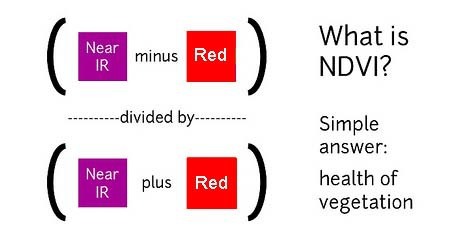](/i/44723) **NDVI = (Near Infrared - Red)/(Near Infrared + Red)** NDVI is a ratio which tries to emphasize photosynthesis while filtering out sun glare. The above equation is run for every pixel, using source data from an infrared photo and a visible light photo, like this pair: [](https://publiclab.org/system/images/photos/000/021/771/original/5390895115_c9d4d38fec_o.jpg) The result can be false-colored to make the high-photosynthesis areas more clear, and used to examine where plants are and how healthy they are. [](https://publiclab.org/system/images/photos/000/021/770/original/PetVISNDVIcomp.png) _Figure above: Normal color photo (right) and normalized difference vegetation index (NDVI) image (left). NDVI image was derived from two color channels in a single photo taken with a camera modified with a special infrared filter. Note that tree trunks, brown grass, and rocks have very low NDVI values because they are not photosynthetic. Healthy plants typically have NDVI values between 0.1 and 0.9. -- @cfastie_ ### Activities Here are a range of activities you can do to produce and interpret your own NDVI imagery, whether downloaded from a satellite imagery provider or [collected yourself using a DIY technique](/wiki/multispectral-imaging) [activities:ndvi] ****   Most DIY converted cameras today (those from Public Lab) use RGN instead of NRG, so the blue channel represents infrared instead of the red channel. That looks like this: [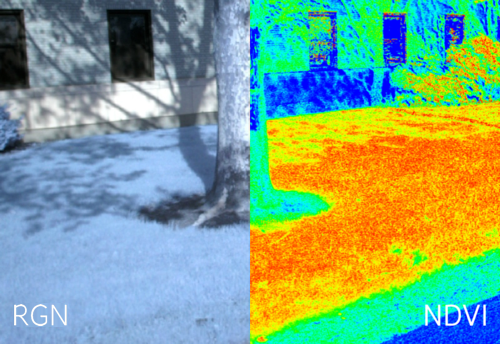](/i/45468?s=o) **** ## NRG imagery Some people are also interested in producing NRG imagery (like the below image), where `Near-Infrared, Red, and Green` are used to compose a picture instead of the usual `Red, Green, and Blue`. [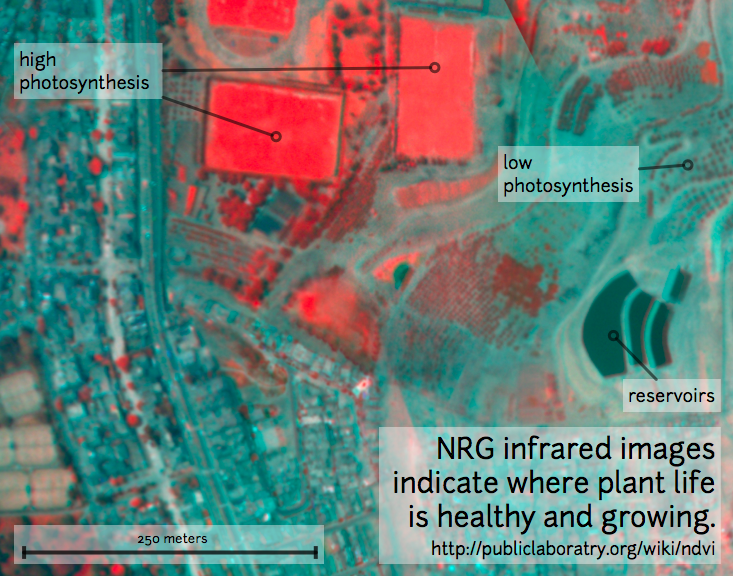](/i/25064) This diagram explains the swapping, which allows us to 'see' infrared as if it were a normal color: [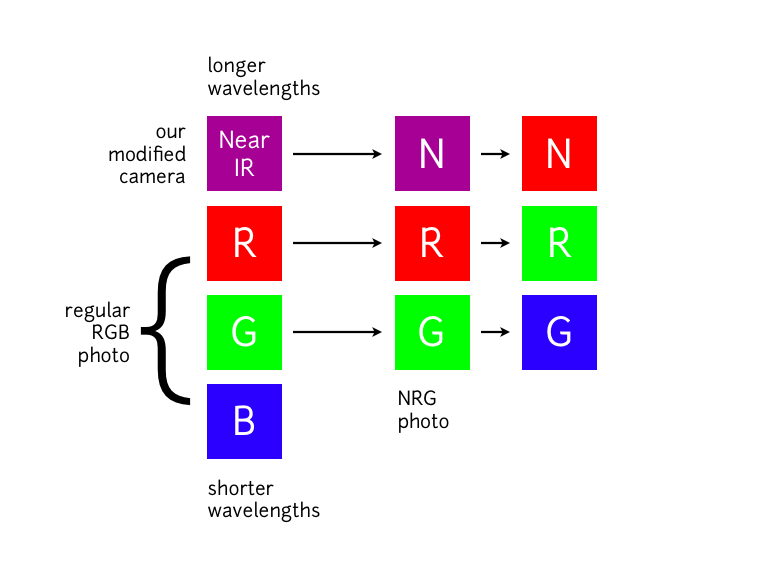](/i/25063) **In NRG images, the deeper and clearer the red color, the denser and healthier the vegetation (more or less).** ### Questions [questions:ndvi] ### Other examples of DIY NDVI imaging From around the internet: Begin watching at 2 minutes to see the resulting imagery: *This topic is part of the [Grassroots Mapping Curriculum](/wiki/mapping-curriculum) series.* **** [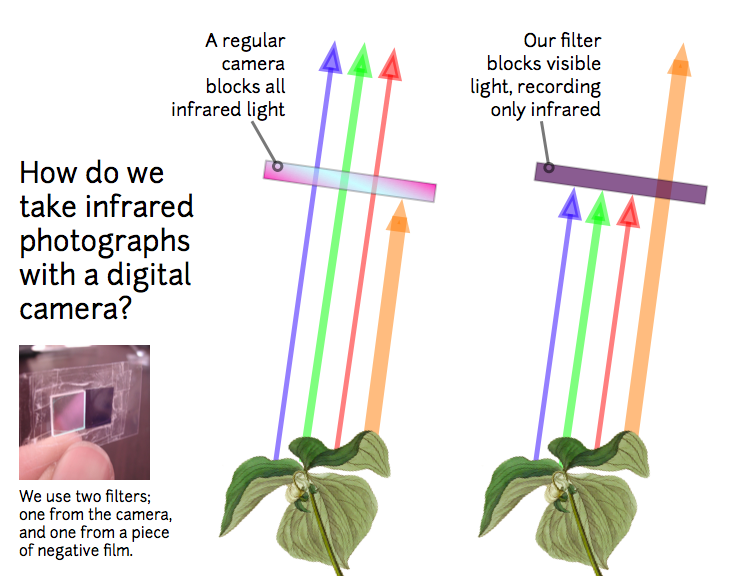](/i/25066) [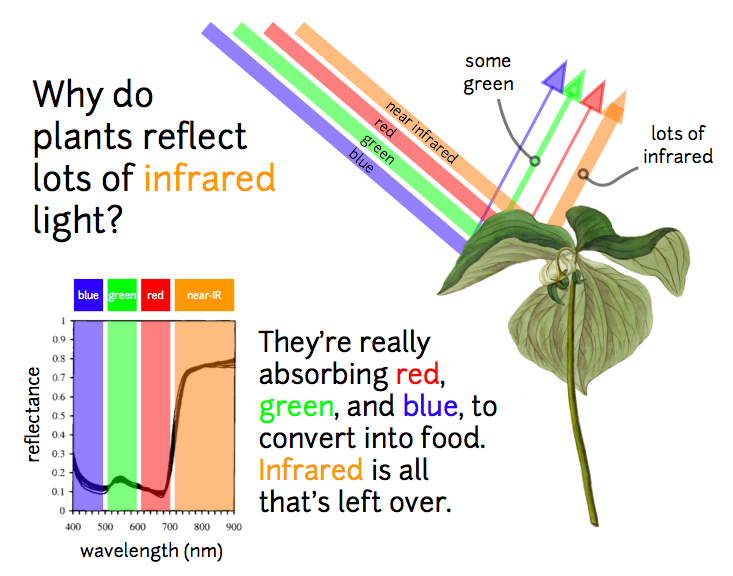](/i/25065) ...
| Author | Comment | Last activity | Moderation | ||
|---|---|---|---|---|---|
| cfastie | "That's a much better filter for the job: It would be great to try some before all the greenery disappears. " | Read more » | about 11 years ago | |||
| nedhorning | "I got a 3" x 3" Wratten 25A gel filter on ebay for $10. There's a lot left over if you want to try it. " | Read more » | about 11 years ago | |||
| cfastie | "Oh yeah, I forgot I actually measured that, and you're right a little more NIR gets into the blue channel (I used a 735nm cutoff filter). I need to..." | Read more » | about 11 years ago | |||
| nedhorning | "Chris - It's interesting that you find that the Canon Powershots don't record much NIR in the blue channel. I found just the opposite - that the bl..." | Read more » | about 11 years ago | |||
| cfastie | "I am confused about the idea of using a red filter instead of blue in a one camera NDVI system. Is the idea to use the red channel for visible ligh..." | Read more » | about 11 years ago | |||
| nedhorning | "Thanks for your comments. I am rethinking the idea that a blue filter is sensitive to chlorophyll absorption. Blue wavelengths have similar reflect..." | Read more » | about 11 years ago | |||
| funkycbj | "A blue filter should be an acceptable alternative to a red filter when measuring vegetation if the spectral response of the blue filter is sensitiv..." | Read more » | about 11 years ago | |||
| nedhorning | "Thanks for the comments Chris. I would be a little cautious drawing more than very broad conclusions at this point. The reflectance values for the ..." | Read more » | about 11 years ago | |||
| cfastie | "Ned, This is really good data. The primary result seems to be that the calibration procedure works incredibly well. Similar NDVI results are produ..." | Read more » | about 11 years ago | |||
| patcoyle | "What fun Chris. Great imagery! " | Read more » | about 11 years ago | |||
| cfastie | "That's a cool idea. I'm sure somewhere in the gradient from near to far the NDVI in these images is correct. " | Read more » | about 11 years ago | |||
| nedhorning | "You could try to use some of these for calibration using Landsat imagery to estimate NDVI. " | Read more » | about 11 years ago | |||
| bc512 | "hey warren my infragram image is posted right at the top of the page in high quality if you would like to have a go " | Read more » | about 11 years ago | |||
| mark9700 | "Hello Everybody Quite interesting materials ! " | Read more » | about 11 years ago | |||
| IntiE | "Hello, you can also play with the Digital Numbers focusing on the values you are interested (see histogram and min/max values), you can use many f..." | Read more » | about 11 years ago | |||
| warren | "Hi, can you post your raw Infragram image? So we can try? " | Read more » | about 11 years ago | |||
| bsugar | "Have you custom white balanced your Infrablue camera? http://publiclab.org/notes/cfastie/07-17-2013/balancing-act http://publiclab.org/wiki/infrab..." | Read more » | over 11 years ago | |||
| cfastie | "The NDVI image looks pretty good to me, but I don't know much about your process or expectations. Fill us in and we might be able to help (guidelin..." | Read more » | over 11 years ago | |||
| cfastie | "The infrablue photos from the camera for this scene is here: http://publiclab.org/notes/warren/05-27-2013/infragram-test-photos-from-a-plane-window " | Read more » | over 11 years ago | |||
| bc512 | "I would love to see the raw image of this if possible? what setup are you using etc? thank you " | Read more » | over 11 years ago | |||
| cfastie | "Great to know a blue sky can produce a white balance setting with so much separation of the blue and red (NIR) channels. there is at least one othe..." | Read more » | over 11 years ago | |||
| ceefoster | "I pointed the camera at a very dark sky-blue sky, standing in the shade. It was a completely clear day, and I got the very orangey images as a resu..." | Read more » | over 11 years ago | |||
| cfastie | "Wow, you must have used something really blue to white balance. Please let us know how you did that. The Infragram is definitely orange. It looks l..." | Read more » | over 11 years ago | |||
| ceefoster | "OK, thanks for the tips. I adjusted the white balance so the images are more orangey. However, now the blue channel image generated does not look l..." | Read more » | over 11 years ago |